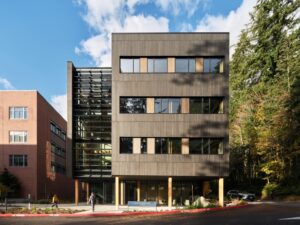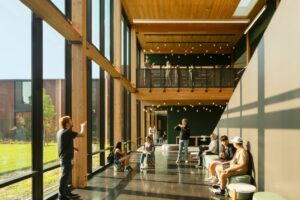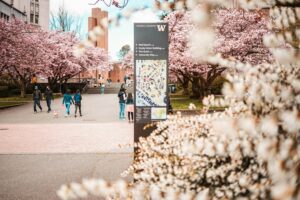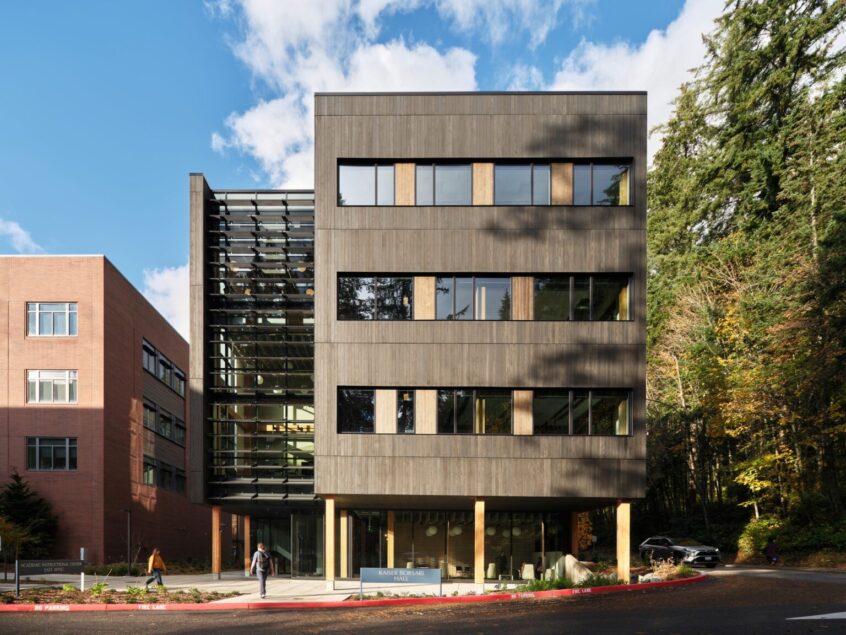Wood is experiencing a revival in architecture and construction – and it’s not just about aesthetics or nostalgia. Thanks to groundbreaking research, a desire for more sustainable living, and innovative wood products, traditional wood and mass timber are redefining how we design, build, and inhabit our built environment.

Western Washington University Kaiser Borsari Hall.
As evidence with its 2025 Wood in Architecture Awards, the Wood Products Council celebrated nine exceptional projects that reflect this evolution. Among the nine honored were two from Washington state: the Washington School for the Deaf Divine Academic and Hunter Gymnasium in Vancouver and Kaiser Borsari Hall at Western Washington University. The two standout honorees demonstrate how wood can be both beautiful and smart for the future.
It’s no coincidence that these educational institutions chose wood to support learning and creativity. Wood’s biophilic properties – it’s ability to connect people to nature – offer psychological and physiological benefits. There’s a growing body of evidence that show natural building materials bring warmth, calm and creativity to our built environments. Increasingly, schools, offices and health care spaces are using elements like daylight, greenery, ventilation, and, yes, wood to reduce stress, foster inspiration, and support overall well-being.

Washington School for the Deaf Divine Academic and Hunter Gymnasium.
But the appeal of wood goes beyond the human experience. As consumers, civic leaders, and businesses demand more sustainable alternatives to carbon-intensive steel and concrete, wood has emerged as a compelling solution.
Wood is renewable, and thus, inherently sustainable. It requires less energy to produce than carbon or steel. Even better, it stores carbon throughout the wood product’s lifespan.
Research has consistently found that large, prefabricated wood products like mass timber panels have great potential to reduce the carbon footprint of buildings as they help displace high-embodied‑carbon materials like concrete and steel. But a recent University of Washington (UW) study looked at the use of mass timber beyond the first life and found that innovative wood products can be reused, recycled and repurposed to provide further environmental benefits.
When a structure is eventually retired, that carbon captured in the wood product doesn’t have to be released – it can be retained through reuse and repurposing of the timber. That means more climate benefits, longer-lasting materials, and less waste, according to the study.

The University of Washington campus in spring.
The environmental promise of wood also paves the way for new economic opportunities. The UW study highlights emerging economic possibilities like a second-life market for mass timber components. This presents exciting opportunities for innovation, job creation, and new industries focused on climate-friendly construction, material recovery, recycling, and the potential to repurpose the wood for a second, third or even fourth use, the study suggests.
Mass timber and engineered wood also spawn new architectural possibilities. These products are lightweight, yet strong and precision-manufactured offsite to reduce construction waste, time, and noise.
As demand grows for greener, more sustainable communities, wood offers a compelling, carbon-friendly solution. It is renewable, resilient, sustainable, and is a natural solution to climate change with half of its weight carbon – not just for the life a building, but for the life beyond it.
